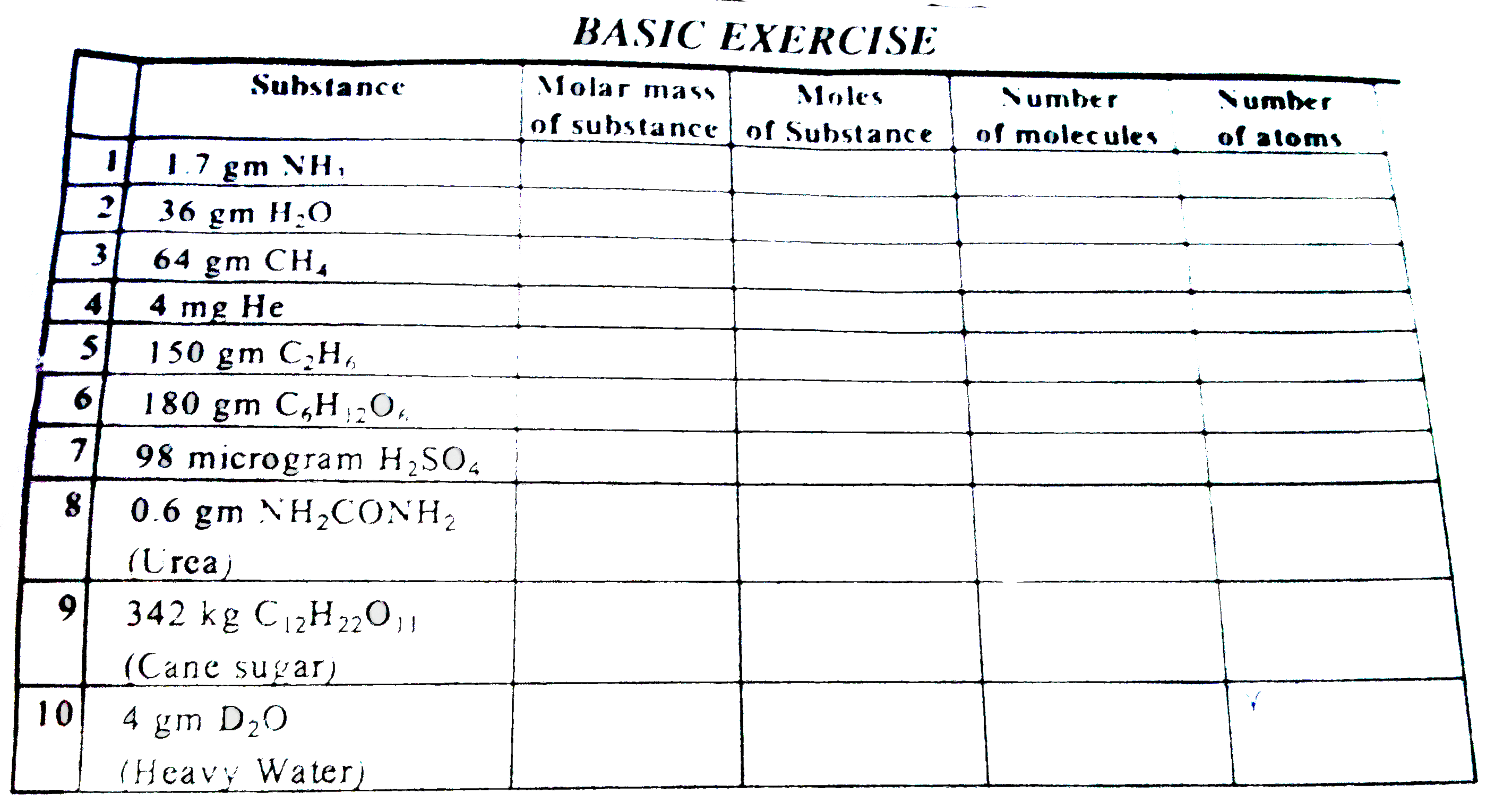The volume of a gas at pressure 1.2×107Nm−2 and temperature 127∘C is 2.0 litre. Find the number of molecules in the gas.
The correct Answer is:4.35×1024
To solve the problem of finding the number of molecules in a gas given its pressure, volume, and temperature, we can follow these steps:
Step 1: Write down the given data
- Pressure (P) = 1.2×107N/m2
- Temperature (T) = 127∘C
- Volume (V) = 2.0liters
Step 2: Convert the temperature to Kelvin
To convert Celsius to Kelvin, we use the formula:
T(K)=T(°C)+273
So,
T=127+273=400K
Step 3: Convert the volume from liters to cubic meters
1 liter is equal to 10−3 cubic meters. Therefore,
V=2.0liters=2.0×10−3m3
Step 4: Use the Ideal Gas Equation
The Ideal Gas Equation is given by:
PV=nRT
Where:
- P = pressure
- V = volume
- n = number of moles
- R = gas constant (8.314J/(mol K))
- T = temperature in Kelvin
Step 5: Rearrange the equation to solve for n
n=PVRT
Step 6: Substitute the values into the equation
Substituting the known values:
n=(1.2×107N/m2)(2.0×10−3m3)(8.314J/(mol K))(400K)
Step 7: Calculate n
Calculating the numerator:
1.2×107×2.0×10−3=2.4×104
Calculating the denominator:
8.314×400=3325.6
Now substituting back:
n=2.4×1043325.6≈7.22moles
Step 8: Calculate the number of molecules
To find the number of molecules, we use Avogadro's number, which is 6.022×1023molecules/mole:
Number of molecules=n×NA
=7.22×6.022×1023
Step 9: Perform the final calculation
Calculating the number of molecules:
=7.22×6.022≈43.46×1023≈4.346×1024molecules
Final Answer
The number of molecules in the gas is approximately 4.346×1024.
---
- Pressure (P) = 1.2×107N/m2
- Temperature (T) = 127∘C
- Volume (V) = 2.0liters
To convert Celsius to Kelvin, we use the formula:
T(K)=T(°C)+273
So,
T=127+273=400K
1 liter is equal to 10−3 cubic meters. Therefore,
V=2.0liters=2.0×10−3m3
The Ideal Gas Equation is given by:
PV=nRT
Where:
- P = pressure
- V = volume
- n = number of moles
- R = gas constant (8.314J/(mol K))
- T = temperature in Kelvin
n=PVRT
Substituting the known values:
n=(1.2×107N/m2)(2.0×10−3m3)(8.314J/(mol K))(400K)
Calculating the numerator:
1.2×107×2.0×10−3=2.4×104
Calculating the denominator:
8.314×400=3325.6
Now substituting back:
n=2.4×1043325.6≈7.22moles
To find the number of molecules, we use Avogadro's number, which is 6.022×1023molecules/mole:
Number of molecules=n×NA
=7.22×6.022×1023
Calculating the number of molecules:
=7.22×6.022≈43.46×1023≈4.346×1024molecules
The number of molecules in the gas is approximately 4.346×1024.
Topper's Solved these Questions
- BOOK - SL ARORACHAPTER - TRANSIENT CURRENTEXERCISE - Type C17videos
TRANSIENT CURRENT
- BOOK - SL ARORACHAPTER - TRANSIENT CURRENTEXERCISE - Type D13videos
TRANSIENT CURRENT
- BOOK - SL ARORACHAPTER - TRANSIENT CURRENTEXERCISE - Type A22videos
TRANSIENT CURRENT
- BOOK - SL ARORACHAPTER - THERMOELECTRICITYEXERCISE - Problems for Self Practice13videos
THERMOELECTRICITY
- BOOK - SL ARORACHAPTER - UNIVERSEEXERCISE - PROBLEM_TYPE6videos
UNIVERSE
Similar Questions
Knowledge Check
- Question 1 - Select One
The pressure P, volume V and temperature T of a gas in the jqar A and other gas in the jar B as at pressure 2P, volume V/4 and temperature 2T, then the ratio of the number of molecules in the jar A and B will be
A1:1B1:2C2:1D4:1 - Question 2 - Select One
The dipole moment of each molecule of a paramagnetic gas is 1.5×10−23amp×m2. The temperature of gas is 27∘ and the number of molecules per unit volume in it is 2×1026m−3. The maximum possible intensity of magnetisation in the gas will be
A3×103amp/mB4×10−3amp/mC5×105amp/mD6×10−4amp/m - Question 3 - Select One
The pressure P, Volume V and temperature T of a gas in the jar A and the other gas in the jar B at pressure 2P, volume V/4 and temperature 2T, then the ratio of the number of molecules in the jar A and B will be
A1:1B1:2C2:1D4:1
A jar.contains gas G1 ar pressure p, volume V and temperature T. Another jar contains gas G2 at pressure 2p, volume V/2 and temperature 2T. What is the ratio of the number of molecules of G1 to that of G2?
View Solution10 gm of oxygen at a pressure 3×105N/m2 and temperature 10∘C is heated at constant pressure and after heating it occupies a volume of 10 litres. (a) Find the amount of heat received by the gas and (b) the energy of thermal motion of gas molecules before heating.
View SolutionOxygen is present in a 1-litre flask at a pressure of 7.6×10−10 mmHg at 0°C. Calculate the number of oxygen molecules in the flask.
View SolutionA compressed cylinder of gas contains 1.50×103 g of N2 gas at a pressure of 2.0×107 Pa and a temperature of 17.1∘C. What volume of gas has been released into the atmosphere if the final pressure in the cylinder is 1.80×105 Pa ? Assume ideal behaviour and that the gas temperature is unchanged.
View SolutionIf pressure and temperature of an ideal gas are doubled and volume is halved, the number of molecules of the gas
View Solution


